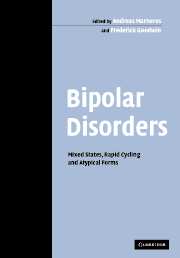
-
Select format
-
- Publisher:
- Cambridge University Press
- Publication date:
- 10 August 2009
- 06 October 2005
- ISBN:
- 9780511544019
- 9780521835176
- Dimensions:
- (247 x 174 mm)
- Weight & Pages:
- 0.974kg, 406 Pages
- Dimensions:
- Weight & Pages:
- Subjects:
- Psychiatry and Clinical Psychology, Medicine, Psychiatry
You may already have access via personal or institutional login- Subjects:
- Psychiatry and Clinical Psychology, Medicine, Psychiatry
Book description
Bipolar disorder manifests itself in a variety of forms. It can coexist with other psychiatric conditions, and treatment efficacy can depend on the type of bipolar state. This book covers the full range of atypical, rapid cycling and transient forms of bipolar disorder, from atypical and agitated depression to schizoaffective mixed states. The most recent ICD category is covered, and the authors also look at the biology and genetics of bipolar disorder, along with issues relating to age (children and the elderly), comorbidity, choice of drug treatment and investigational strategies.
Reviews
'This is a very useful reference for those dealing with patients with atypical features of bipolarity. The authors have done an excellent job of presenting the difficult to treat but commonly prevalent forms of bipolar disorder.'
Source: Doody's Reviews
'… this is a book to have and to read, appropriate for, and likely to be enjoyed by, both interested clinicians and learned 'Bipolarologists' alike.'
Source: Journal of Clinical Psychiatry
'The strength of this book lies in the way it details the historical development of these forms of bipolar disorder, provides a thorough description of their manifestations, critically reviews the latest empirical evidence, and discusses the implications for diagnosis, pharmacological intervention and future research.'
Source: Journal of Mental Health
Contents
Metrics
Altmetric attention score
Full text views
Full text views help Loading metrics...
Loading metrics...
* Views captured on Cambridge Core between #date#. This data will be updated every 24 hours.
Usage data cannot currently be displayed.
Accessibility standard: Unknown
Why this information is here
This section outlines the accessibility features of this content - including support for screen readers, full keyboard navigation and high-contrast display options. This may not be relevant for you.
Accessibility Information
Accessibility compliance for the PDF of this book is currently unknown and may be updated in the future.


